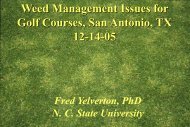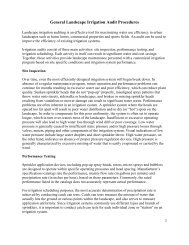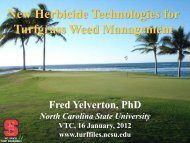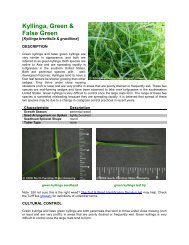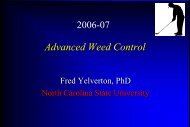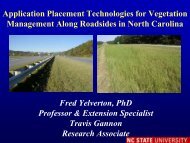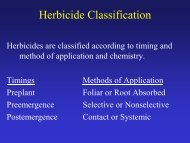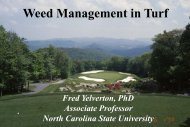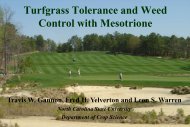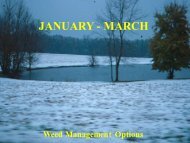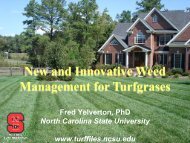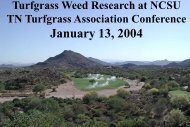Carolina Athletic Fields: - TurfFiles - North Carolina State University
Carolina Athletic Fields: - TurfFiles - North Carolina State University
Carolina Athletic Fields: - TurfFiles - North Carolina State University
- No tags were found...
You also want an ePaper? Increase the reach of your titles
YUMPU automatically turns print PDFs into web optimized ePapers that Google loves.
IrrigationAerification/TopdressSlicing/VerticuttingMowingOverseedingSupplemental irrigation is necessary to maintain a desirable playing surface. During the spring and summer (in the absence ofrain), irrigation will be necessary a minimum of one to two times weekly. The general guidelines provided in the calendar representestimations based on long-term weather patterns. Adjust the irrigation needs as appropriate for the current conditions. Donot irrigate between 10 am and 4 pm to promote water conservation, and follow local ordinances. Be aware that more rigorouswater restrictions may be imposed by the county.Suggest that fields be aerified a minimum of three times yearly, once in the spring (April or May), again in mid summer, andthen in fall. This relieves compaction, allows better soil-oxygen penetration, and encourages deeper rooting. Cores can beredistributed with a dragmat. Topdressing would be very useful to level out low spots in the playing surface. Topdressing shouldbegin in early spring immediately following core aerification and fertilization. The topdressing sand should ideally be spreadconsistently and worked into the turf with a dragmat. A routine topdressing rate is ¼ inch in depth. Exercise care when choosinga topdressing material to meet your objectives (drainage, water retention, etc.).Slicing can be used during the growing season for some alleviation of compaction and to improve turf growth. Verticuttingshould only be done if thatch is excessive, and only during the summer when the grass can rapidly recover.Proper mowing promotes deeper rooting and a more stress-tolerant plant. Mow often so that no more than 30% of the foliageis removed at one mowing Highly maintained bermudagrass fields require two to three mowings weekly. A reel-type mowerproduces the finest cut, but rotary mowers may be used if the blades are sharp. Bermudagrass fields are normally mowed to aheight of ¾ to 1½ inches. An overseeded field should be mowed a little higher (1 to 2½ inches).Overseeding provides fall and winter color and protects bermudagrass when it is dormant. Overseeding can add a significantexpense to a maintenance budget so it should not be performed unless time, effort, and money are allocated. Normaloverseeding time is when the daytime temperatures are in the low 70s. This is usually mid September to early November in NC.Perennial ryegrass is the best choice. Annual or Intermediate ryegrass may be used but expect lower quality, especially in thespring. A typical seeding rate for these grasses is 8 to 20 pounds of seed per 1,000 square feet (350 to 870 pounds per acre),depending on desired appearance and budget constraints.19



